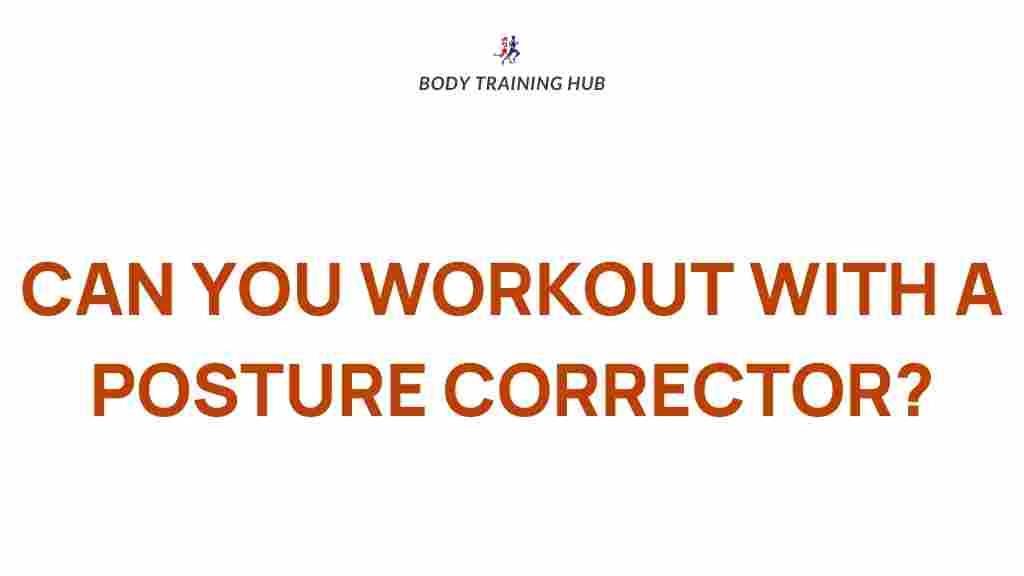Uncover the Truth: Exercising with a Posture Corrector
In today’s fast-paced world, maintaining good posture can often take a backseat to our busy lifestyles. Many individuals spend hours hunched over computers or looking down at their phones, leading to various musculoskeletal issues. Enter the posture corrector—a tool designed to help improve alignment and support better posture. But how effective is it when combined with a workout? In this article, we’ll explore the benefits of using a posture corrector during exercise, debunk common myths, and provide insights into how to incorporate it into your fitness routine.
The Benefits of Using a Posture Corrector During Workouts
Using a posture corrector while exercising can provide several benefits:
- Improved Posture: A posture corrector encourages correct alignment, which can lead to better posture during workouts and daily activities.
- Enhanced Performance: Good posture can improve breathing and oxygen flow, enhancing overall performance during exercises.
- Reduced Risk of Injury: Proper alignment minimizes strain on muscles and joints, lowering the risk of injuries.
- Increased Awareness: Wearing a posture corrector raises awareness of body mechanics, helping you maintain good posture even when not exercising.
Understanding Posture Improvement
Posture improvement is not just about standing up straight. It involves developing a balanced alignment of the body that supports movement and reduces tension. When using a posture corrector, it’s essential to understand how it works to enhance your workouts:
- Supports the Spine: A good posture corrector aligns the spine, encouraging the muscles to engage correctly during exercises.
- Strengthens Core Muscles: By promoting better posture, a posture corrector can help activate and strengthen core muscles essential for stability.
- Facilitates Muscle Memory: Regular use of a posture corrector can aid in developing muscle memory for maintaining good posture even after the device is removed.
Common Myths and Facts About Posture Correctors
Myth 1: Posture Correctors Are Only for People with Back Pain
Fact: While individuals with back pain may benefit significantly from posture correctors, they are also useful for anyone looking to improve their posture, including athletes and fitness enthusiasts.
Myth 2: Posture Correctors Are a Quick Fix
Fact: A posture corrector is not a magic solution. It should be used in conjunction with exercises aimed at strengthening the back, core, and shoulder muscles for long-term benefits.
Myth 3: Wearing a Posture Corrector Means You Don’t Have to Exercise
Fact: Using a posture corrector can enhance workouts, but it cannot replace the need for regular exercise. Physical activity is crucial for overall health and posture improvement.
Myth 4: Posture Correctors Are Uncomfortable
Fact: While it may take some time to adjust, many modern posture correctors are designed for comfort and can be worn during various activities, including workouts.
How to Incorporate a Posture Corrector into Your Workout Routine
Integrating a posture corrector into your fitness routine can be straightforward. Here’s a step-by-step process to ensure you gain the most benefits:
Step 1: Choose the Right Posture Corrector
Select a posture corrector that fits comfortably and suits your specific needs. Consider factors such as:
- Size and adjustability
- Material and breathability
- Type (full back, upper back, etc.)
Step 2: Start Slowly
If you’re new to using a posture corrector, start by wearing it for short periods. Gradually increase the duration as your body adjusts to the support it provides.
Step 3: Combine with Core Strengthening Exercises
Incorporate exercises that strengthen your core and back muscles, such as:
- Planks
- Bridges
- Rows
- Back extensions
Step 4: Maintain Awareness During Workouts
Pay attention to your posture while exercising. The posture corrector serves as a reminder to engage your core and align your spine correctly.
Step 5: Mix in Flexibility Training
Incorporate stretching exercises to enhance flexibility, which can contribute to better posture. Yoga and pilates are excellent options.
Step 6: Monitor Your Progress
Keep track of your posture improvement over time. You can take pictures or note how your body feels during and after workouts to assess the effectiveness of the posture corrector.
Troubleshooting Tips for Using a Posture Corrector
While using a posture corrector can be beneficial, you may encounter some issues. Here are troubleshooting tips to address common concerns:
Discomfort or Pain
If the posture corrector causes discomfort:
- Check the fit; it should be snug but not overly tight.
- Limit the wearing time and gradually increase it.
- Consider consulting a professional if pain persists.
Difficulty Adjusting to Wearing It
Adjusting to a posture corrector can take time:
- Start with short durations and gradually increase.
- Wear it during low-impact activities before trying it during workouts.
Not Seeing Results
If you’re not noticing improvements:
- Ensure you’re using it consistently.
- Combine it with strength and flexibility exercises.
- Evaluate your overall posture habits outside of workouts.
Conclusion: The Path to Better Posture and Fitness
Incorporating a posture corrector into your workout routine can be a game-changer for improving posture and enhancing overall fitness. By understanding the benefits, debunking the myths, and following a structured approach, you can enjoy a more effective and safe exercise experience.
Remember, achieving good posture is a journey that requires consistency and dedication. Pair your posture corrector with targeted exercises, and you’ll be on your way to a stronger, more aligned body. For further information on fitness and health, check out this comprehensive guide to optimizing your workouts.
For those seeking additional support and tips, feel free to explore our article on posture improvement techniques to enhance your journey toward better posture and overall fitness.
This article is in the category Myths & Facts and created by BodyTraining Team
